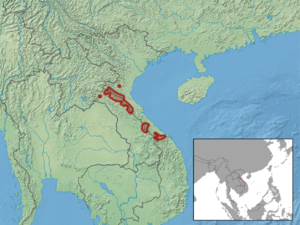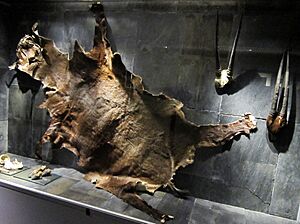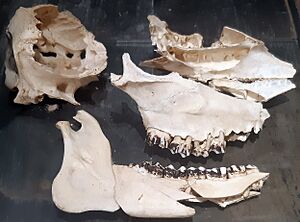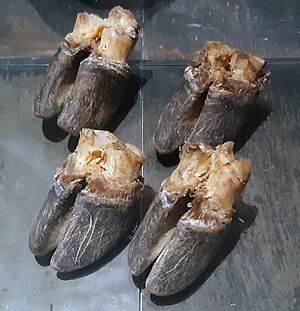Saola facts for kids
Quick facts for kids Saola |
|
|---|---|
 |
|
| Conservation status | |
| Scientific classification | |
 |
|
| Range in Vietnam and Laos |
The saola (Pseudoryx nghetinhensis), also known as the spindlehorn or Asian unicorn, is one of the rarest large mammals on Earth. This animal lives in forests in the Annamite Range, a mountain area in Vietnam and Laos. It is a type of bovine, which means it's related to cattle.
Scientists first described the saola in 1993. This happened after they found some remains of the animal in Vũ Quang National Park. A team from Vietnam's Ministry of Forestry and the World Wide Fund for Nature (WWF) made this discovery. Saolas have been kept by humans a few times, but they usually only lived for a few weeks or months. The first photo of a living saola was taken in 1993. The most recent photo was taken in 2013 by a special camera in the forest. The saola is the only species in its group, called Pseudoryx.
Contents
Discovery and Classification
In May 1992, a team from Vietnam's Ministry of Forestry went to explore the animals and plants in the new Vu Quang National Park. On May 21, they found a skull with strange, long, pointed horns from a local hunter. The next day, they found another similar pair of horns. The team realized these belonged to a new species of bovid. They called it the "saola" or "Vu Quang ox." The WWF officially announced this amazing discovery on July 17, 1992.
Finding such a large animal like the saola was very surprising. It was the first large mammal discovered in the area in 50 years! Since then, people have seen live saolas only a few times, mostly in the Annamite Range.
The saola's scientific name is Pseudoryx nghetinhensis. It is the only member of its genus, Pseudoryx, and belongs to the family called Bovidae. Scientists officially described the species in 1993. The saola looks very different from other bovids, which is why it has its own special genus.
Scientists have used DNA to study the saola. This research helps them understand how the saola is related to other animals. They found that the saola is part of a group that includes cattle and buffaloes. Some scientists even think the saola might be so unique that it should have its own new group!
What's in a Name?
The name 'saola' means "spinning-wheel post horn" in a local language from Vietnam. This name comes from the way its horns look, like the posts on a spinning wheel. In the Lao language, it means the same thing. The scientific name nghetinhensis refers to two Vietnamese provinces, Nghệ An and Hà Tĩnh. The name Pseudoryx means "false oryx" because the saola looks a bit like the oryx, an animal found in Arabia or Africa.
The Hmong people in Laos call the saola saht-supahp, which means "the polite animal." They say this because it moves quietly through the forest. In the news, saolas are sometimes called "Asian unicorns." This is because they are so rare and are said to be gentle.
Physical Description
In 1998, a scientist named William G. Robichaud studied a female saola named 'Martha' in Laos. She was about 84 centimetres (33 in) tall at the shoulder. Her back was a little higher than her shoulders. Her body and head together were about 150 centimetres (4.9 ft) long.
Saolas have a chocolate brown coat with white patches on their face, throat, and neck. Their neck and belly are a lighter brown. They have a black stripe along their back. Both male and female saolas have a pair of horns that are almost parallel.
Their hair is soft and thin, about 1.5–2.5 centimetres (0.59–0.98 in) long. It's short on their head and neck but thicker on the inside of their front legs and belly. A dark stripe about 0.5 centimetres (0.20 in) thick runs from their shoulders to their tail. The tail is about 23 centimetres (9.1 in) long and has three parts: brown at the base, black at the tip, and white in the middle. Saola skin is about 1–2 millimetres (0.039–0.079 in) thick, but it's thicker near the neck and shoulders. This thicker skin helps protect them from predators and other saolas during fights. Saolas usually weigh between 80–100 kilograms (180–220 lb).
The saola has round pupils and dark-brown eyes that look orange when light shines on them. They have white whiskers about 2 centimetres (0.79 in) long on their chin, which they probably use to feel things. The saola can stick out its tongue up to 16 centimetres (6.3 in) to reach its eyes and face.
Saolas have special glands on their face that produce a strong-smelling, grayish-green liquid. They rub this liquid on rocks and plants to mark their territory. Their footprints are about 5–6 centimetres (2.0–2.4 in) long for the front legs and 6 centimetres (2.4 in) long for the back legs.
Both male and female saolas have horns. They are dark brown or black and about 35–50 centimetres (14–20 in) long, which is twice the length of their head. The horns are usually about 20 centimetres (7.9 in) apart at the tips.
Where Saolas Live
The saola lives in a very small area compared to other large mammals. They prefer wet evergreen or deciduous forests in eastern Southeast Asia, especially in river valleys. People have seen them in steep river valleys at heights of 300–1,800 metres (980–5,910 ft) above sea level. In Vietnam and Laos, their home covers about 5,000 km2 (1,900 sq mi), including four nature reserves. During the colder months, they might move to lower areas.
Ecology and Behaviour
Local people say that saolas are active both during the day and at night. However, they prefer to rest during the hottest parts of the day. The captive female saola studied by Robichaud was mostly active during the day. When she rested, she would pull her front legs close to her belly, stretch her neck so her chin touched the ground, and close her eyes.
Even though they seem to be solitary animals, saolas have been seen in small groups of two or three, and sometimes even up to six or seven. Their grouping patterns are similar to other animals like the bushbuck or sitatunga.
The captive female saola was calm around people but was scared of dogs. If she saw a dog, she would snort and point her horns forward. Her ears would go back, and she would stand stiffly with her back arched. She would also ignore everything else around her. This female saola would groom herself a lot with her strong tongue. She would also use her facial glands to leave a strong-smelling liquid on rocks and plants to mark her territory. Sometimes, she would make short bleating sounds.
Diet
The saola eats plants. The captive saola liked to eat spleenwort (a type of fern), Homalomena, and different kinds of broad-leaved shrubs and trees. She would chew or pull leaves into her mouth with her long tongue. She mostly ate during the day. Saolas are also known to eat Schismatoglottis, which other plant-eating animals in their area usually don't eat.
Reproduction
Scientists don't know much about how saolas reproduce. They likely have a specific mating season, from late August to mid-November. They usually have only one calf at a time, mostly during the summer, between mid-April and late June. Based on similar animals, it's thought that a saola pregnancy lasts about 33 weeks. Villagers have reported seeing young saolas with their mothers, which suggests that baby saolas are born over a few months.
Conservation Efforts
The saola is currently considered critically endangered. This means it's at a very high risk of disappearing forever. They are in danger because their forest homes are being destroyed or broken up by human activity. Saolas are also hunted for their meat, fur, and for use in traditional medicines. They sometimes get caught in traps meant for other animals like wild boar. Conservation groups have removed more than 26,651 traps from saola habitats.
The saola lives in areas that are far away from people. Hunters value saolas highly because they are so rare. It's hard to change the minds of local hunters who have hunted for generations. The scientific interest in saolas has even made some hunters try to capture live ones. To help protect them, commercial logging has been stopped in the Bu Huong nature reserve, and there's a ban on clearing forests there.
It's hard to study rare animals like the saola because there isn't much information about them. This lack of data makes it difficult to figure out the best ways to protect them. Scientists have never seen a saola in the wild. Because it's unlikely that large groups of saolas still exist, searching for them in the wild isn't the main focus of conservation efforts right now.
The Saola Working Group was created in 2006 by the IUCN Species Survival Commission to protect saolas and their homes. This group includes about 40 experts from Laos and Vietnam, along with biologists and conservationists from organizations like the Wildlife Conservation Society and the World Wide Fund for Nature.
Culture
The mascot for the 2021 Southeast Asian Games was a saola, named Sao La. This design won a contest in 2019, beating out 557 other ideas.
See also
- Leaf muntjac (Muntiacus putaoensis)
- Truong Son muntjac (Muntiacus truongsonensis)
- Giant muntjac (Muntiacus vuquangensis)
- Annamite striped rabbit (Nesolagus timminsi)






